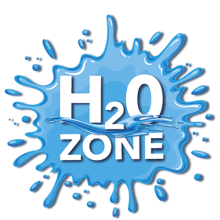Word Glossary
Alternative Water Supply (AWS)
Includes the use of a nontraditional source of water to help meet different freshwater needs of a community. Examples include reusing wastewater or treating seawater through a desalination plant.
Aquifer
An aquifer is an area underground that holds water in the gaps between rock, sand or gravel, sort of like an underground lake or stream.
Compost
Organic material that has been broken down naturally and used as a fertilizer for plants.
Condensation
Water changing from a gas into a liquid — this is how water vapor turns into clouds, fog and those drips that form on the outside of your cold drink.
Conserve
To conserve water means to use it wisely and to not be wasteful.
Desalination
The process of turning salty water from the ocean, into fresh water.
Dissolved Oxygen (DO)
DO refers to the amount of oxygen that is dissolved in water for fish and other organisms to breath.
Ecosystem
An ecosystem is like a neighborhood. It’s a community of plants and animals, including the physical environment they live in. An ecosystem might include a gopher tortoise, the nearby grasses that it eats, the dirt it digs a hole in and the coyote that tries to catch it.
Erosion
Erosion happens when water and wind eat away at rock or soil. Thanks to gravity, erosion moves earth downhill and downstream. Over time, erosion can turn an entire mountain into mud on the bottom of a bay.
Estuary
A semi-enclosed body of water where fresh and salt water mix.
Evaporation
Water changing from a liquid into a gas (water vapor).
Fertilizer
A substance (like manure) or chemical (like diammonium phosphate) that is added to soil to make plants grow better. People put fertilizers on their lawns, and farmers use fertilizers so they can grow crops over and over on the same land. Too much fertilizer can run off into streams or sink into the groundwater.
Florida-Friendly LandscapingTM (FFL)
FFL is a statewide program that uses science-based research to encourage environmentally-friendly landscape practices. There are nine FFL principles.
Gravity
Gravity is the force that pulls everything toward the center of the earth. Gravity is the reason that rain falls from the sky and water runs downhill.
Groundwater
Any water that has trickled into the ground; usually part of an aquifer.
Habitat
A habitat is the specific place where living organisms find the things they need to survive, such as food, shelter, water and space. Not all living things can survive in the same habitat. Factors that determine where an organism can live include sunlight, temperature, food supply and weather.
Herbicide
An herbicide is a substance, like a chemical, used to kill plants. People often use herbicides to kill plants they consider weeds.
Hurricane
A hurricane begins when a storm develops over warm surface waters. As warm air rises in the center of the storm, it creates an upward current of air, called an updraft. The surrounding air is attracted to the storm’s center, where it rises and causes the pressure to drop. The updraft continues to spin and strengthen as more air is drawn in from larger and larger areas surrounding the storm system, creating powerful hurricanes.
Impervious
Ground that isn’t porous is called impervious. Swimming pools are impervious, or they’d leak. Unfortunately, so are paved parking lots, roads and buildings, which means water has trouble sinking into the ground and charging aquifers in developed areas.
Integrated Pest Management (IPM)
IPM is a form of pest management that helps gardeners to manage pests with as few chemicals as possible. Through IPM practices, nasty chemicals are a last resort.
Invasive
Animals and plants are called invasive when they come from somewhere else and overgrow areas of Florida. Once they arrive and start to spread, many are impossible to remove and very expensive to control.
Irrigation
When we deliberately apply water to an area, we’re irrigating it. Farmers use irrigation to water their crops. You might use it to water your yard or garden. Water from irrigation could come from wells, or from dams, canals and pipes that change the course of surface water.
Lake
Lakes are inland bodies of fresh water that can be either natural or constructed and are usually surrounded by land.
Littoral Zone
The littoral zone is the place where land meets water.
Microorganism
A microorganism is a very tiny organism that can only be seen with a microscope. Bacteria, viruses, and fungus are all examples of microorganisms that can pollute our water.
Mulch
Mulch is loose material that you can spread on top of soil. Bark is one of the most common types of mulch.
Native Plants
Native plants are originally from an area or have grown there for thousands of years. These plants are adapted to the local conditions and don’t require “help” from people to grow. They may also be important to local wildlife.
Non-Point Source Pollution
Nonpoint-source pollution is harder to trace because it comes from all of us — from our yards, pets, septic tanks and cars.
Organic
Something that is organic is a natural matter that relates to, or is obtained from, a living thing.
Pathogen
Pathogens, like bacteria or viruses, can cause diseases. An important part of good water management is trying hard to keep pathogens out of the water supply.
Percolation
Water moving through the ground by trickling between the little gaps in sand or rock. Usually water percolates downward from the surface into an aquifer.
Pesticide
A pesticide is a chemical used to kill animal “pests” like insects or sometimes rodents. Some people spray pesticides on their yards, and many farms use them.
pH
pH is a scale from 0 to 14 that measures acidity. Most critters can tolerate a pH between 6.5 and 8.5 — lower numbers mean the water is too acidic, and higher ones mean it is too alkaline.
Photosynthesis
Photosynthesis is the process where plants use sunlight, water, and carbon dioxide to create oxygen and energy in the form of sugar.
Point Source Pollution
You can point your finger at the place where point-source pollution comes from, like a factory or power station.
Porous
The action can’t start unless the ground is porous — that is, full of little holes or gaps. Sand is porous, but much finer clay is not. Solid rock isn’t porous, but Florida’s limestones are usually full of cracks and holes that water can travel through.
Precipitation
Water falling from the sky as rain, snow, sleet or hail.
River
Rivers are freshwater bodies that are created from excess rainwater that flows off the land. Rivers may also receive fresh water inputs from groundwater or smaller tributaries.
Runoff
Runoff is liquid water that moves downhill across the earth’s surface, sometimes slowly (like in a swamp) and sometimes quickly (like in a waterfall).
Solar Energy
Energy provided by the sun for the never-ending water cycle
Spring
A spring occurs when groundwater from the aquifer is forced to the surface of the earth.
Stormwater Runoff
Stormwater runoff occurs when rainwater picks up pollution as it washes over roads, parking lots, driveways, roof tops and other hard surfaces where it cannot soak into the ground. The untreated runoff ends up in nearby waterbodies, along with the many different pollutants it’s picked up along the way.
Surface Water
Surface water is any water on top of the earth, including lakes, rivers and even puddles. We use surface water for fun things like swimming and boating — and sometimes we treat it to make it safe to drink.
Temperature
We know water temperature is important for swimming — it also affects dissolved oxygen, fish, plants and even microbes.
Transpiration
Water that gets drawn up in the roots of plants and then moves out of the leaves and into the air as water vapor. It’s kind of like the plants are drinking with their roots and then sweating with their leaves.
Turbidity
Turbidity measures how clear the water is — or isn’t. Turbid water means there is a lot of debris, silt or other stuff floating around. That makes the water dark and murky, which makes it difficult for plants to grow and animals to breathe.
Urban Water Cycle
The urban water cycle refers to the ways that humans have engineered systems to capture, clean, use and return water to the environment.
Wastewater
Clean water comes out of our taps, sinks and showerheads. After that, it becomes wastewater, which usually runs down a drain. Why is it wastewater? You might make it soapy, flush it, wash dishes with it or just leave the tap running — whatever happens, it turns from clean water into wastewater. So be careful not to waste water!
Water Cycle
The continuous journey water takes as it moves above, below and on the Earth’s surface.
Water Quality
Water quality is a description of the condition of water, similar to how we refer to our health to describe the condition of the human body. Water quality can refer to the chemical, physical and biological condition of water. It also includes evaluating whether water is safe to be used for a specific purpose like drinking, recreation or to support wildlife.
Water Reuse
Water recycling, or reuse, is a form of alternative water supply that captures and reuses wastewater.
Water Supply
Water supply refers to the source and process of providing water to different users.
Water Vapor
In warm or dry weather, solar energy can cause water to evaporate into an invisible gas. We call that gas water vapor.
Watershed
A watershed is an area of land that water flows across or through as it moves toward a common body of water, such as a stream, river, lake or coast. Small watersheds like your own neighborhood can be part of huge watersheds, like the 1.5 million square miles that the Mississippi River drains.
Well
Think of a movie about the olden days. In the center of town is a circle of bricks with a little roof over it and a bucket that drops down into a hole in the ground. It’s a well — and we still use them, though in many places the bricks and buckets have been replaced with pipes and pumps. Houses in the country usually have their own wells, but in more crowded areas you likely get your water from a utility’s well field.
Wetland
Lands that are wet all, or part, of the year. Wetlands can be either freshwater or saltwater habitats.


